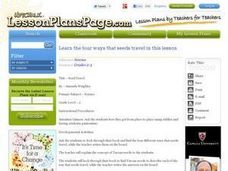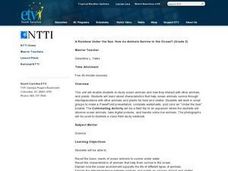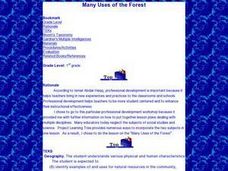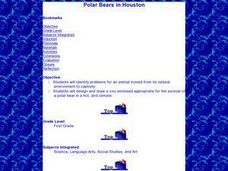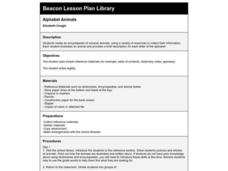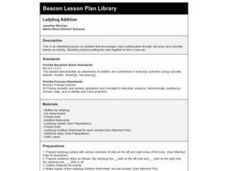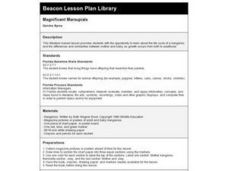Curated OER
See Our Collection
First graders classify plants and animals based on their characteristics using examples from the westward journey of Lewis and Clark and the Corps of Discovery.
Curated OER
Familiarizing Students with the 5 Food Groups
Learners review a variety of foods and classify them into food groups. They identify the benefits of each food group to our bodies and consider how deficiencies of these groups affect humans. They sort pictures, view a video and write...
Curated OER
The Heart
Students explore the parts of the heart and how blood travels throughout the body. They conduct a simple simulation to demonstrate the path that blood takes through the body and the functions it performs.
Curated OER
Seed Travel
Students explore the four different ways that seeds travel. They separate students into different groups and they act out how seeds travel. The groups act out their different scenarios in front of the class.
Curated OER
Food Chain Chant
Learners memorize a poem using various reading strategies to reinforce the concept of the food chain and the terminology associated with it.
Curated OER
The Human Body
Pupils make life-size models of their bodies by having a partner trace them. They glue the basic body parts in the proper places and decorate them with hair, and facial features.
Curated OER
Plant Adaptations
Students identify parts of prairie plants. They sketch the plants indicating its adaptive parts and write brief descriptions of them. They present their findings to the class.
Curated OER
Birds of a Feather
Students investigate birds and complete a variety of bird-themed activities. They read books and observe birds noting their physical characteristics, development and life cycle stages.
Curated OER
Cell Cookie Lesson Plan
Students review the structure and fuctions of plant and animal cells. They use various types of materials such as sugar cookies and cake frosting for this lesson.
Curated OER
A Rainbow Under the Sea: How do Animals Survive in the Ocean?
Second graders read books, watch videos, complete worksheets and participate in class discussions about ocean animals. They, in groups, design PowerPoint presentations on selected marine animals.
Curated OER
Animal Parts Match The Environment
First graders watch a video and discuss animal parts focusing on eating and movement parts. They create an animal puppet with the proper mouth and movement parts.
Curated OER
A Caterpillar's Life
Students use different colors, surface textures, and shapes to create form and meaning to their caterpillar. They also come to recognize that living things have similar needs of water, food and air by teacher reading The Very Hungry...
Alabama Learning Exchange
Very Busy Spiders
Students identify spider parts, and distiguish between web building and wandering spiders. They complete a spider webquest.
Curated OER
Many Uses of the Forest
First graders examine pictures of forest wildlife and identify different animals that live in the forest. They discuss resources the forest provides for human use and explore the concept that the forest is used by many at the same time.
Curated OER
Polar Bears in Houston
First graders read a book about animal babies from the Arctic and discuss what a polar bear needs to survive. They design a suitable zoo habitat for a polar bear using crayons and paper.
Curated OER
How Do Organisms Vary?
Young scholars study variation of organisms. They determine this variation arises from genetic and environmental causes.
Curated OER
Alphabet Animals
Second graders create an encyclopedia of unusual animals, using a variety of resources to collect their information. Each student illustrates an animal and provides a brief description for each letter of the alphabet. A very nice,...
Curated OER
Adopt a Manatee
First graders engage in a writing activity about manatees and use e-mail to contact representatives about important issues. This would be a very exciting, and meaningful lesson for a first grade writer!
Curated OER
Owls and Raptors
Students dissect an owl pellet and identify its contents, after watching the teacher demonstrate the dissection process. Students record their findings on a graph.
Curated OER
Ladybug Addition
Students engage in an interesting lesson on addition that encourages class participation through role-play and concrete hands-on activity. They utilize the fact that ladybugs have dots on their bodies to create a fun, hands-on lesson in...
Curated OER
C.M. Beg
First graders are introduced to a pretend boy named C.M. Beg. The initials of the boy be a mnemonic device to help students explain the basic characteristics of living things.
Curated OER
It's Alive
First graders critically analyze living and nonliving objects, then develop a list of characteristics to classify objects on a science walk. They make a book to close out the lesson.
Curated OER
Magnificent Marsupials
Students have the opportunity to explore the life cycle of a kangaroo, and the differences and similarities between mother and baby as growth occurs from birth to adulthood. They draw pictures of the mother and the joey and compare them.
Curated OER
Ocean Life
Students explore the types of plants and animals that can be found in the ocean. They browse books and/or magazines to identify and gain a knowledge base of plant and animal life found in the ocean, then create a collage.





